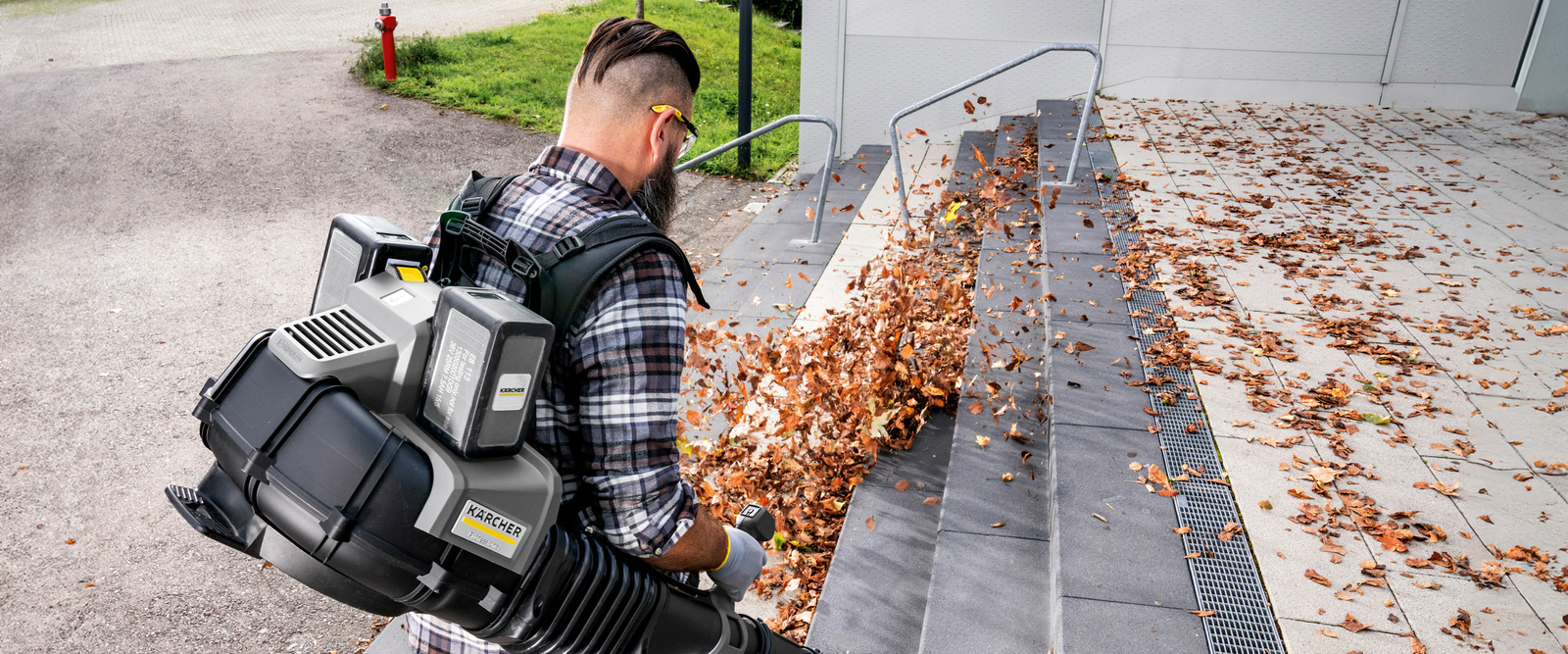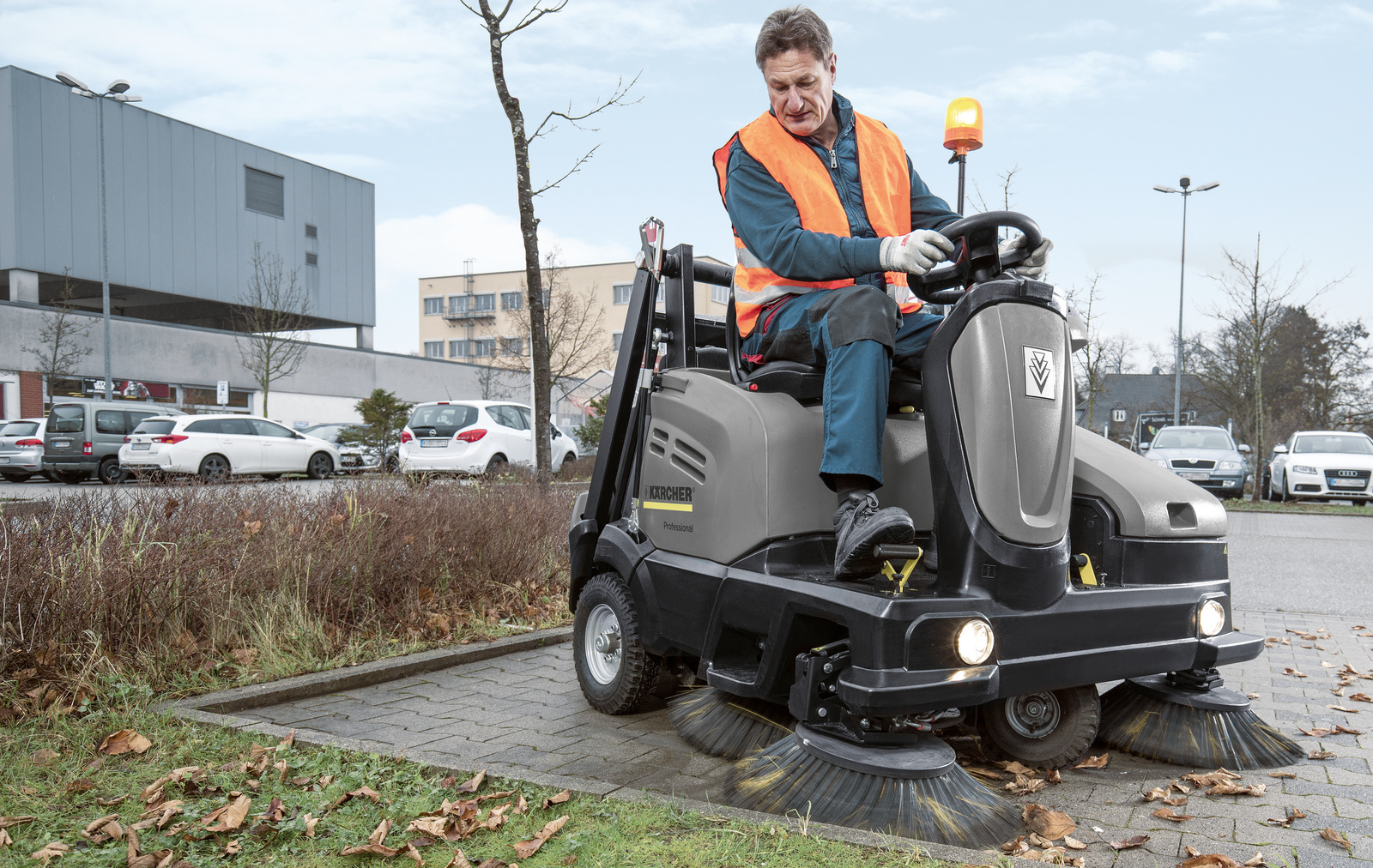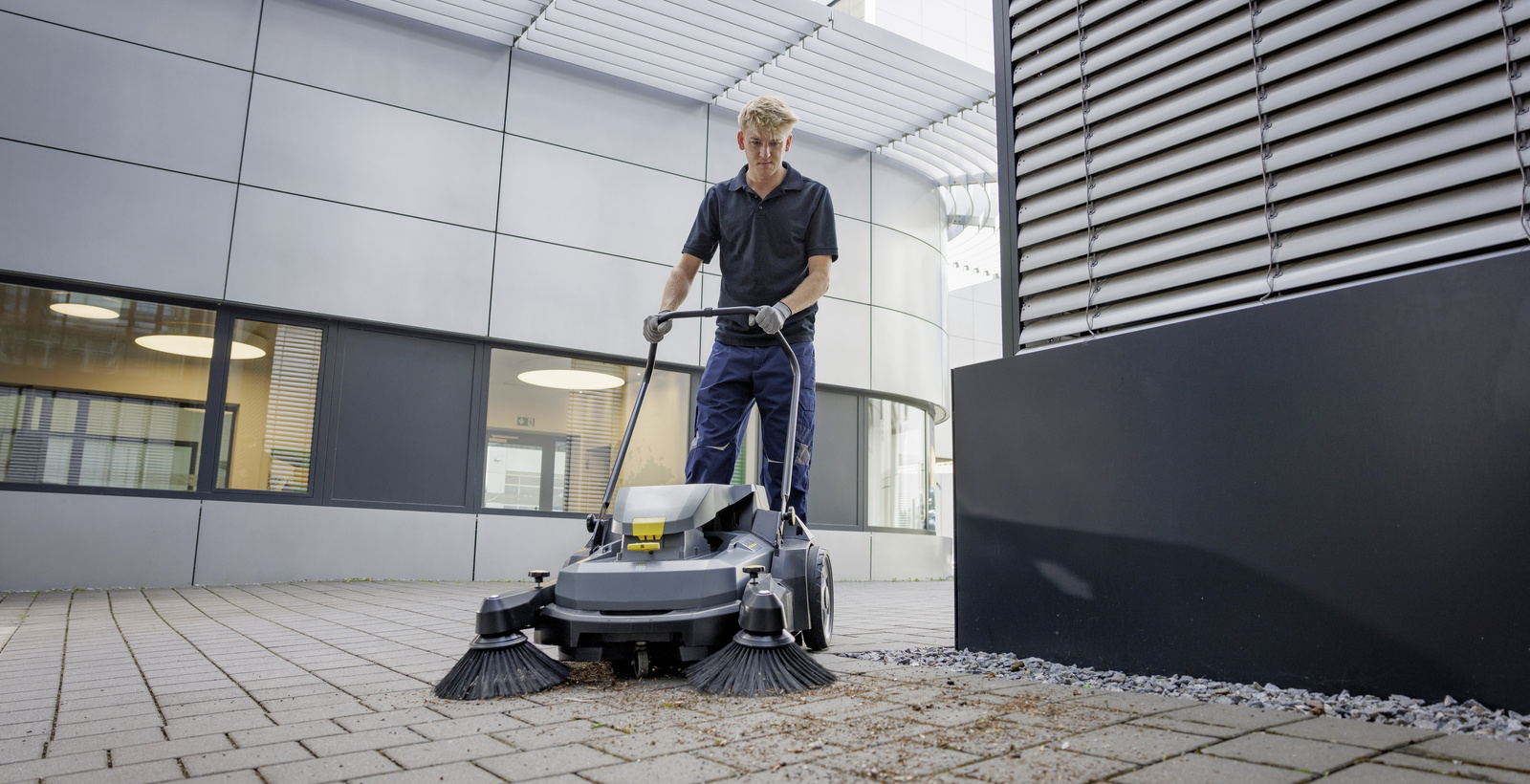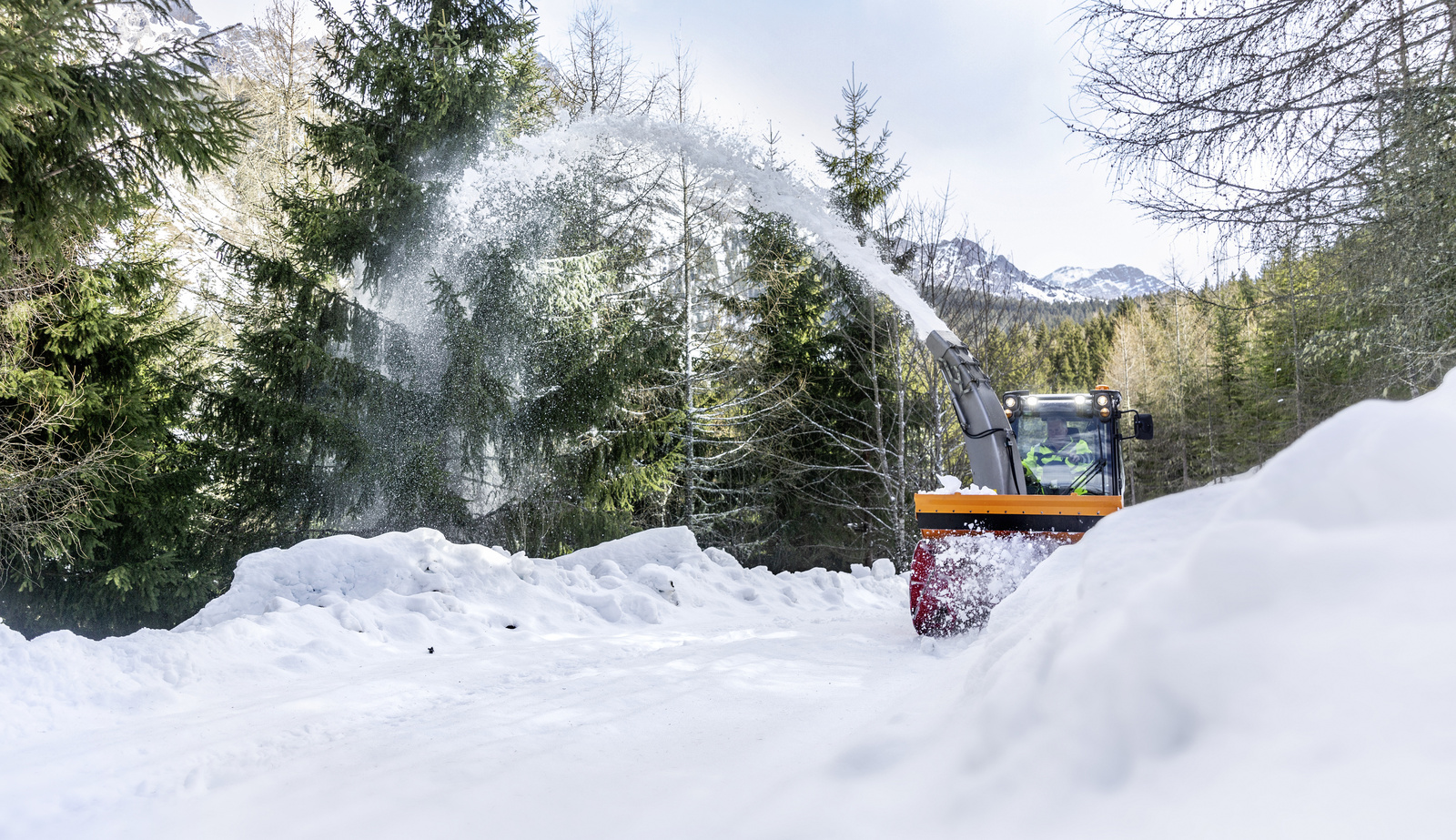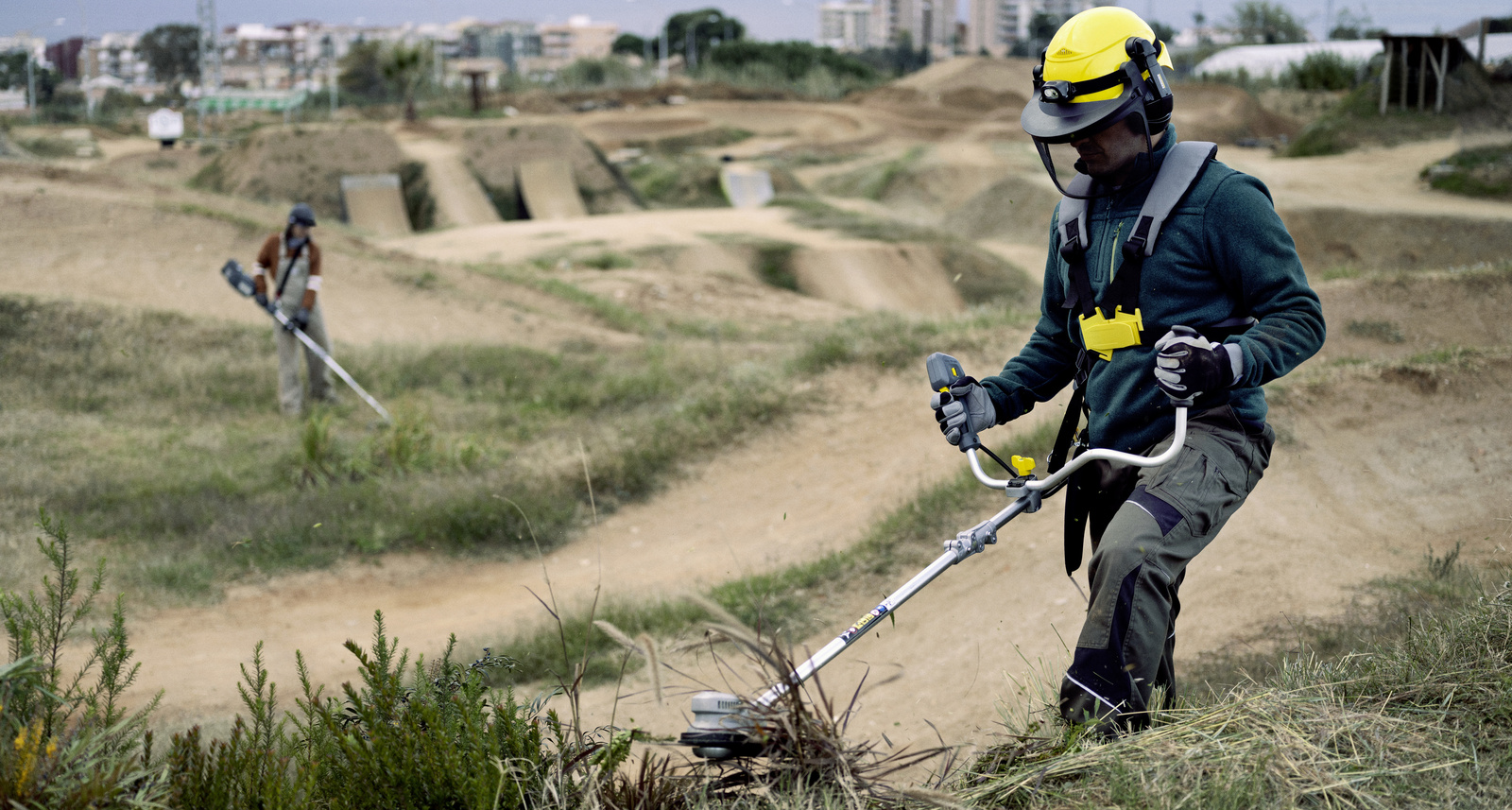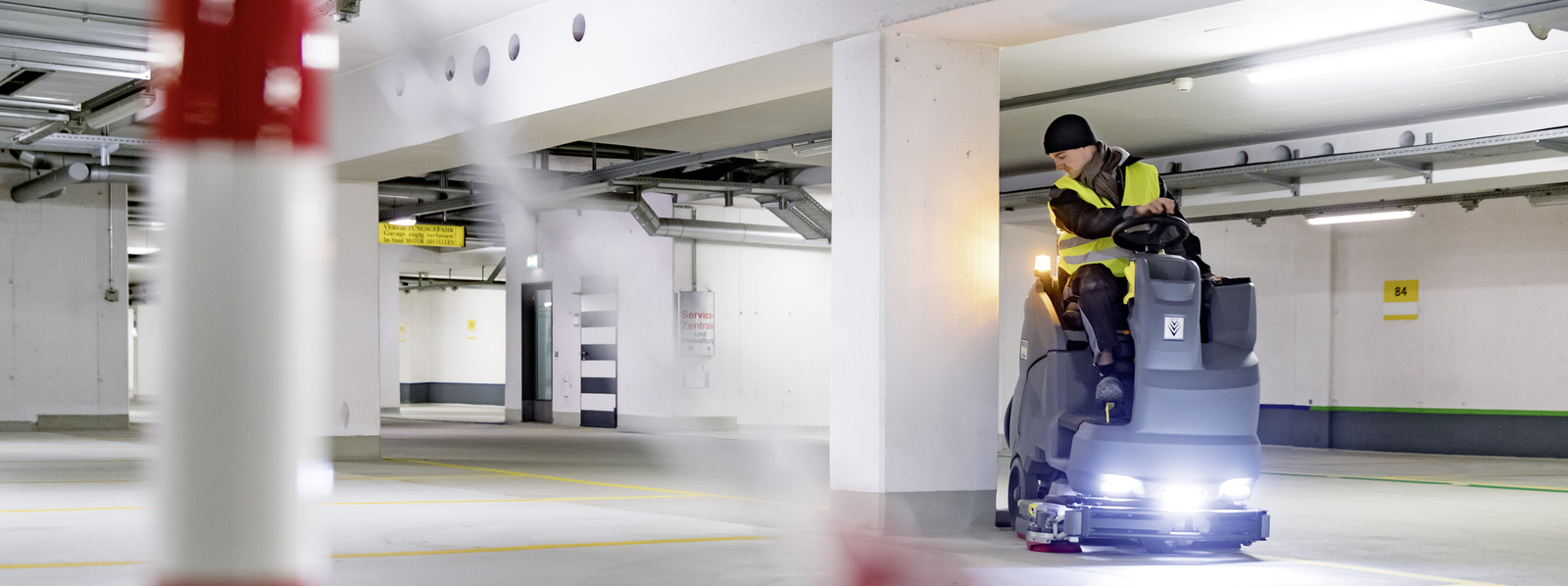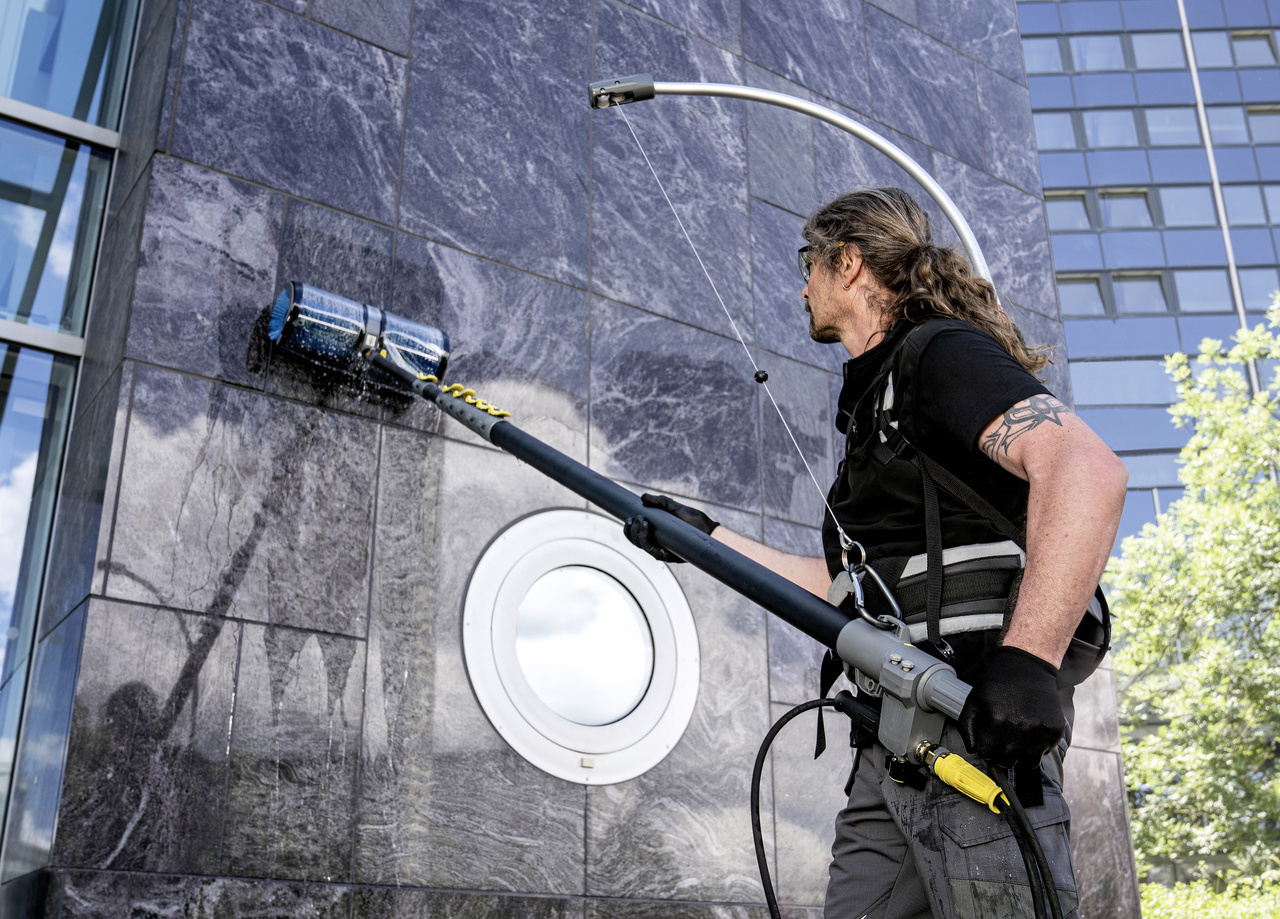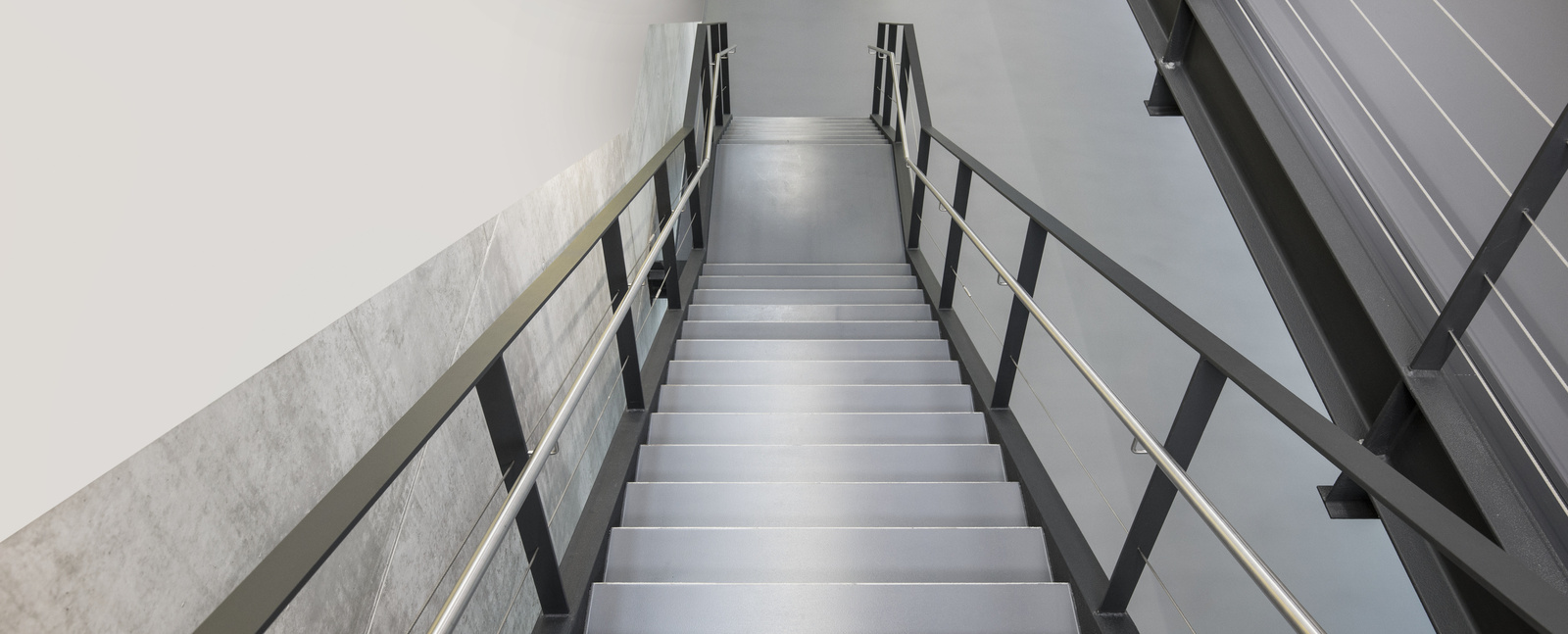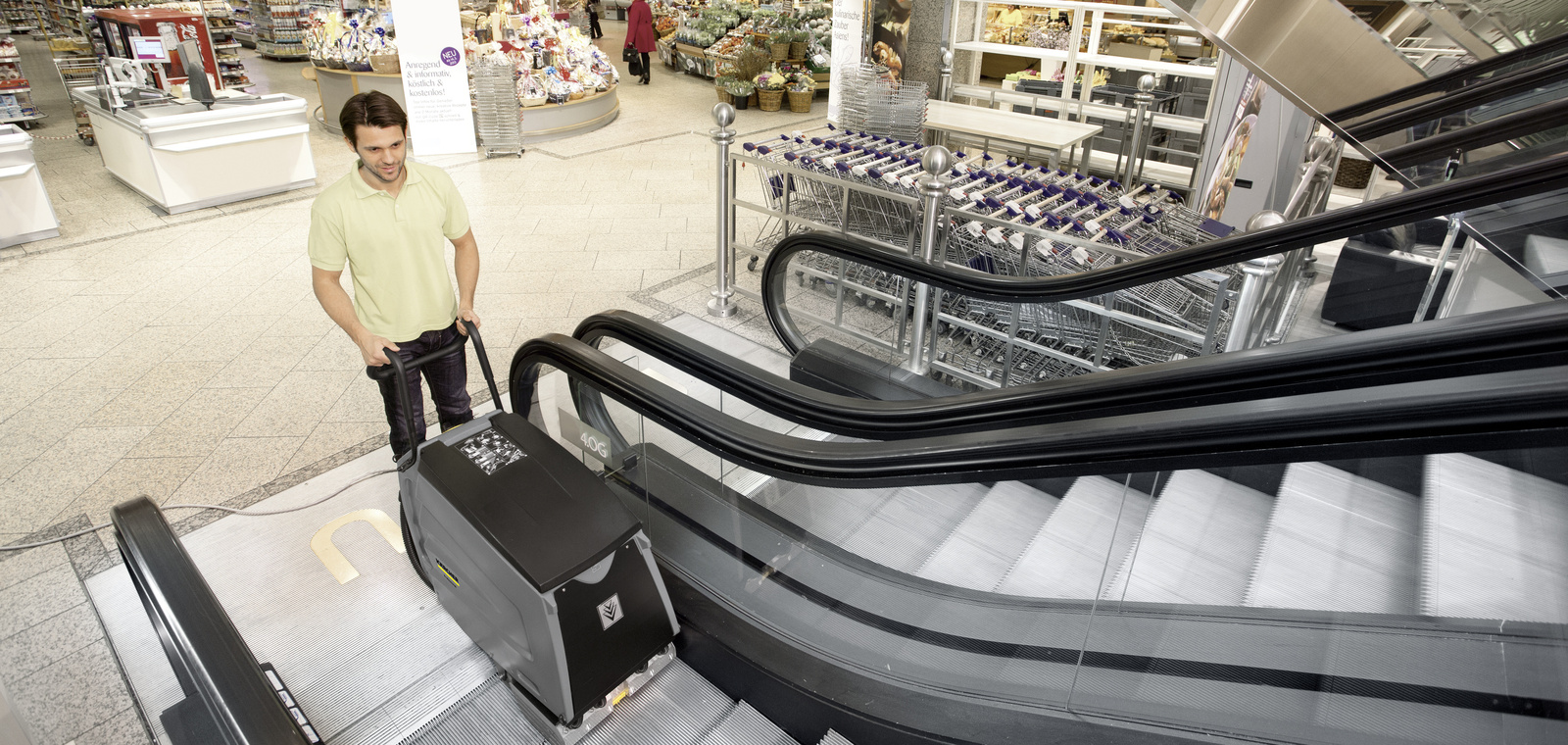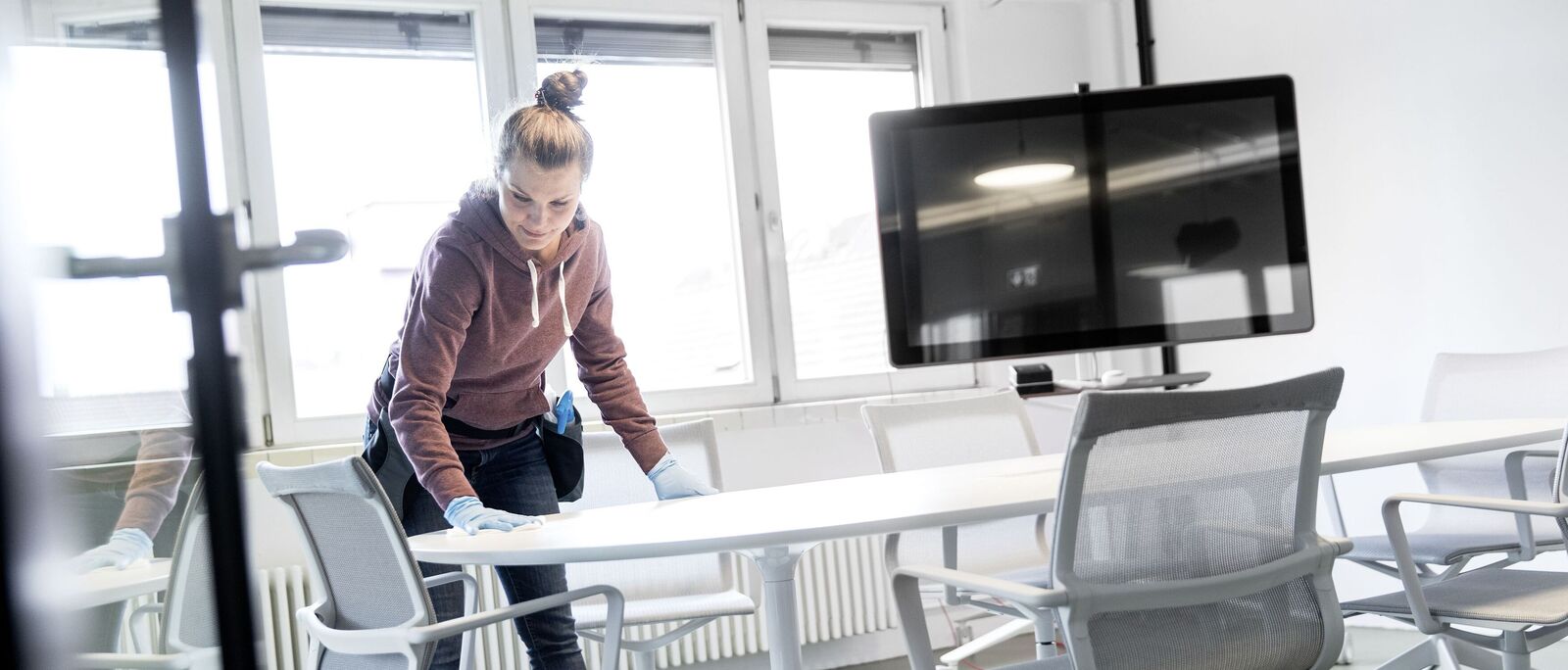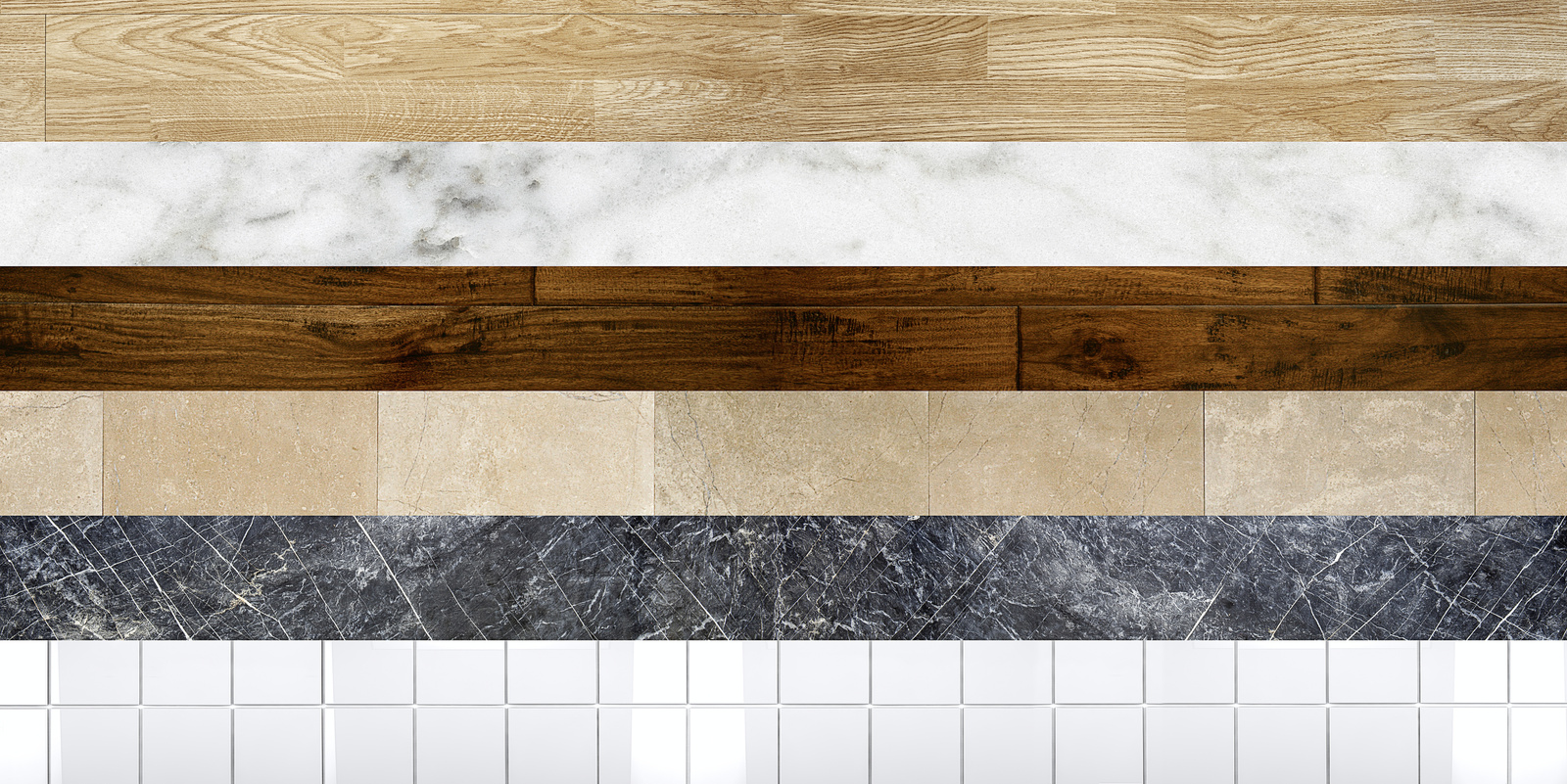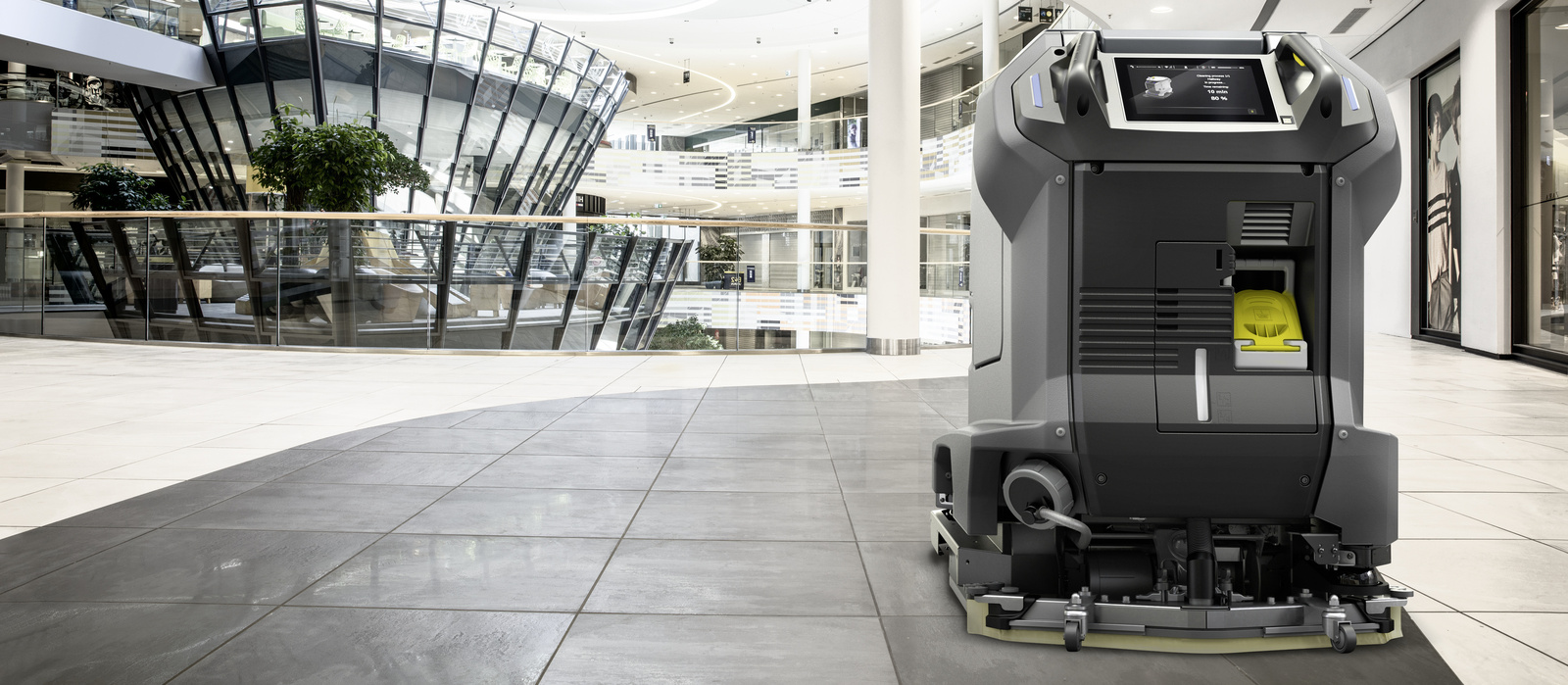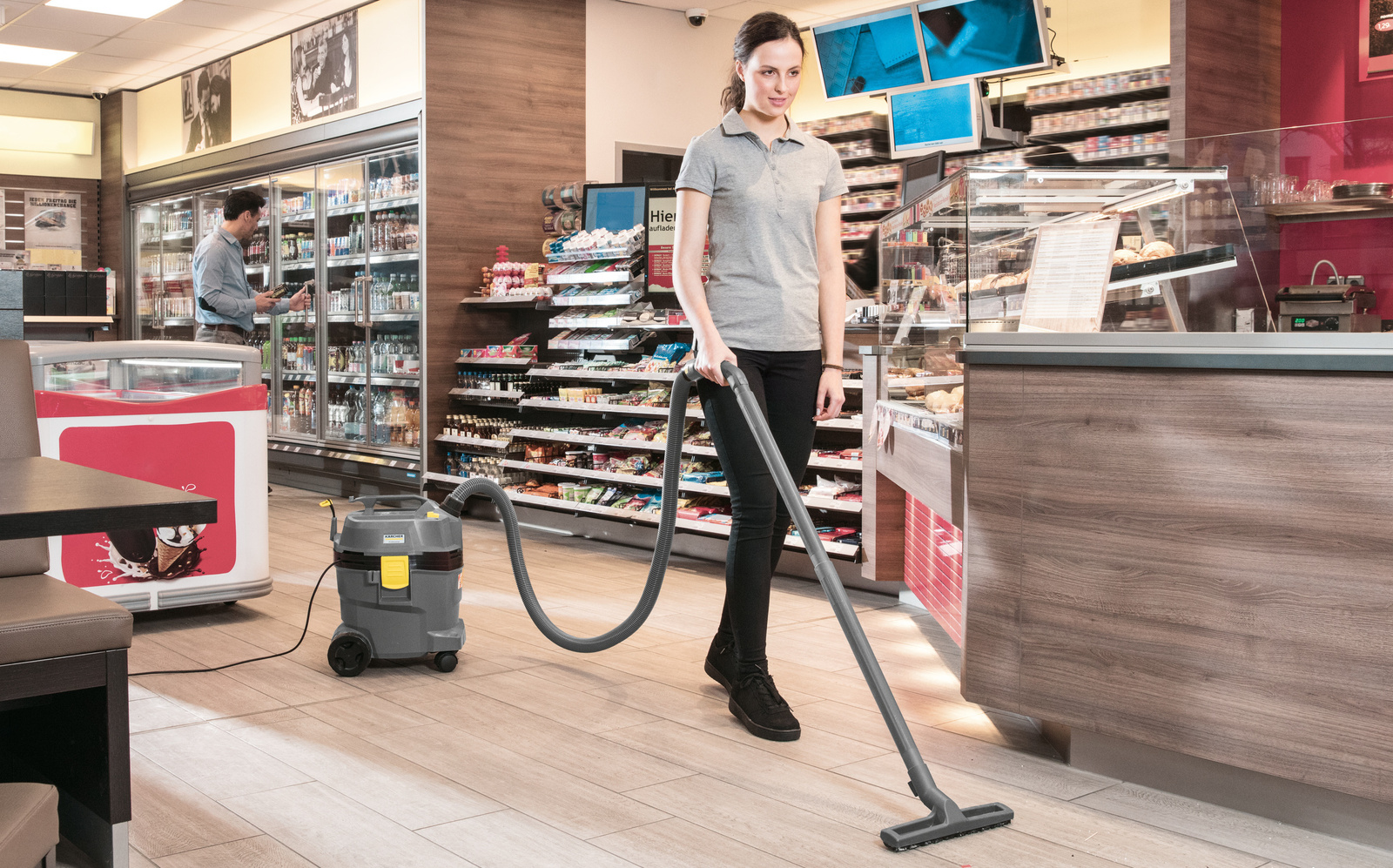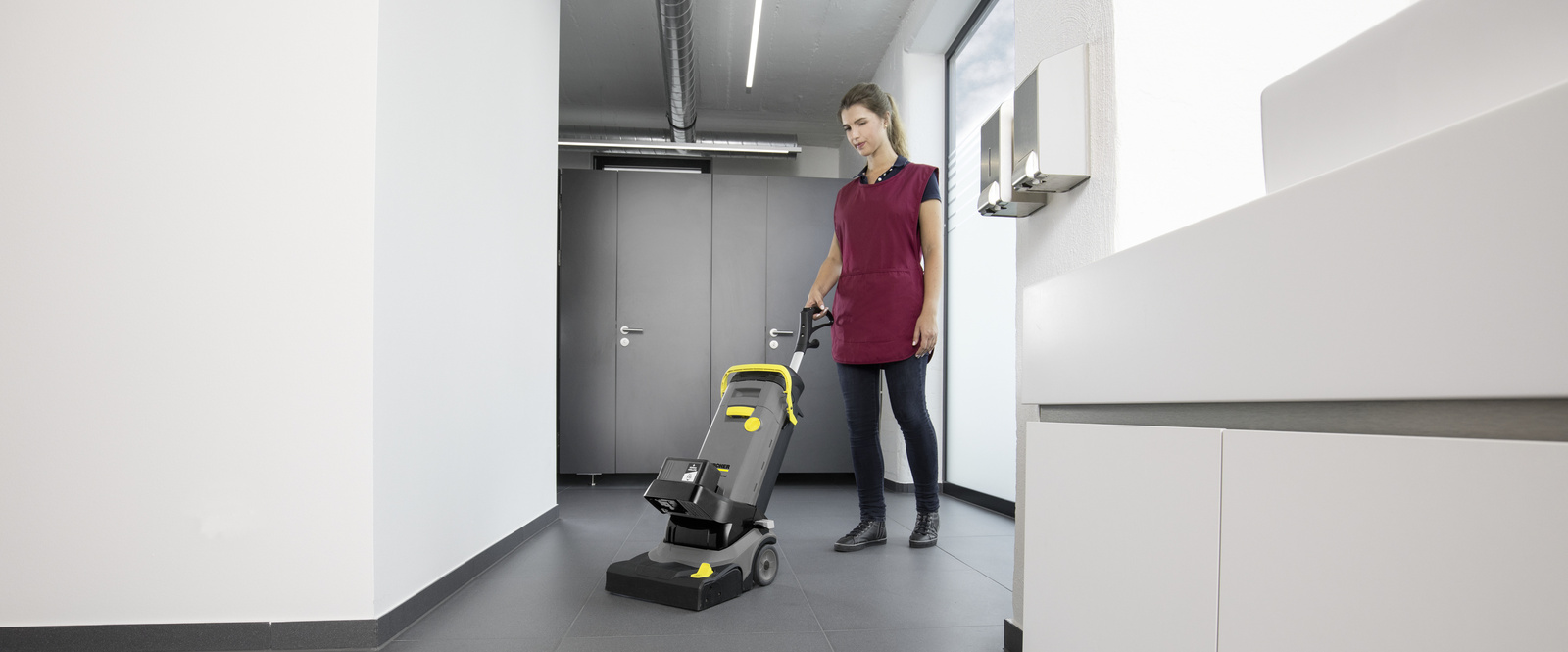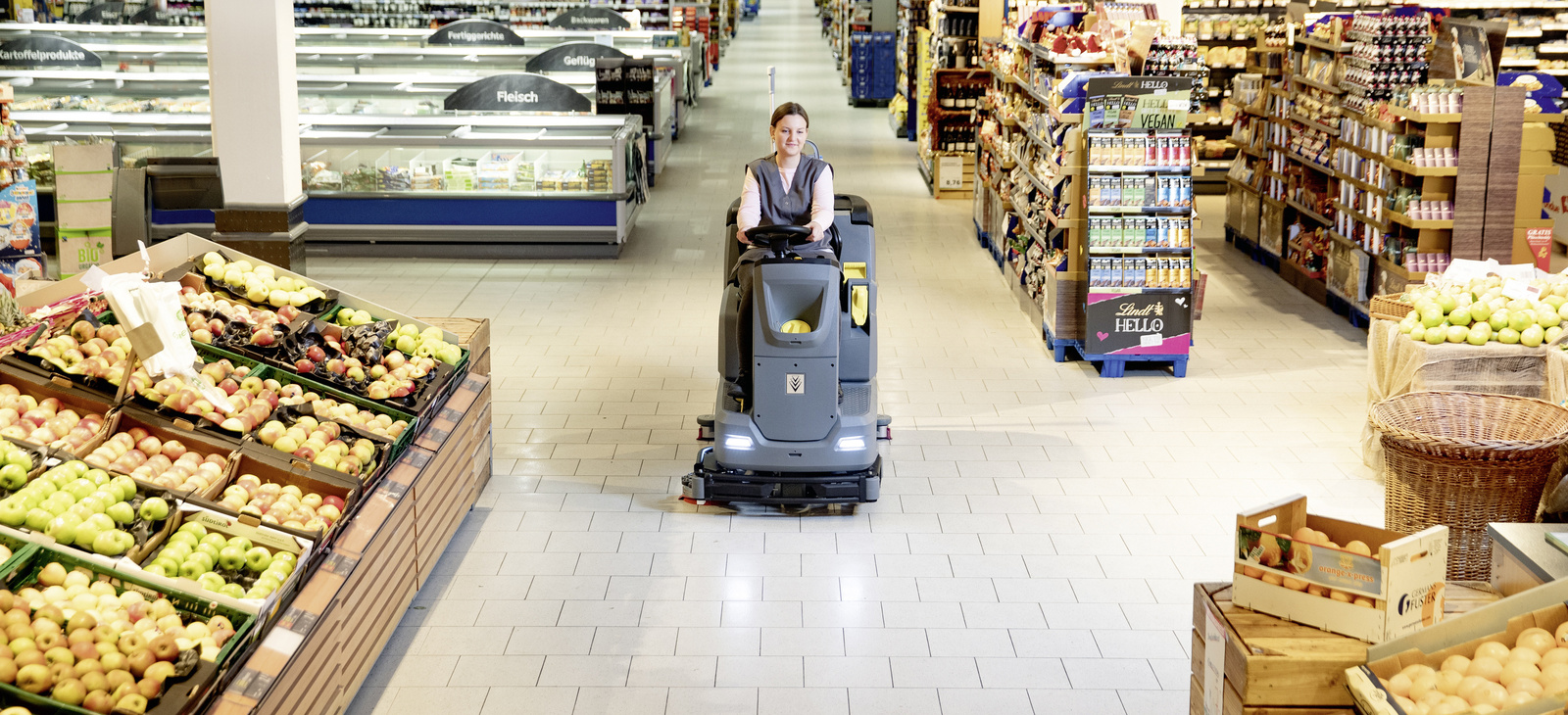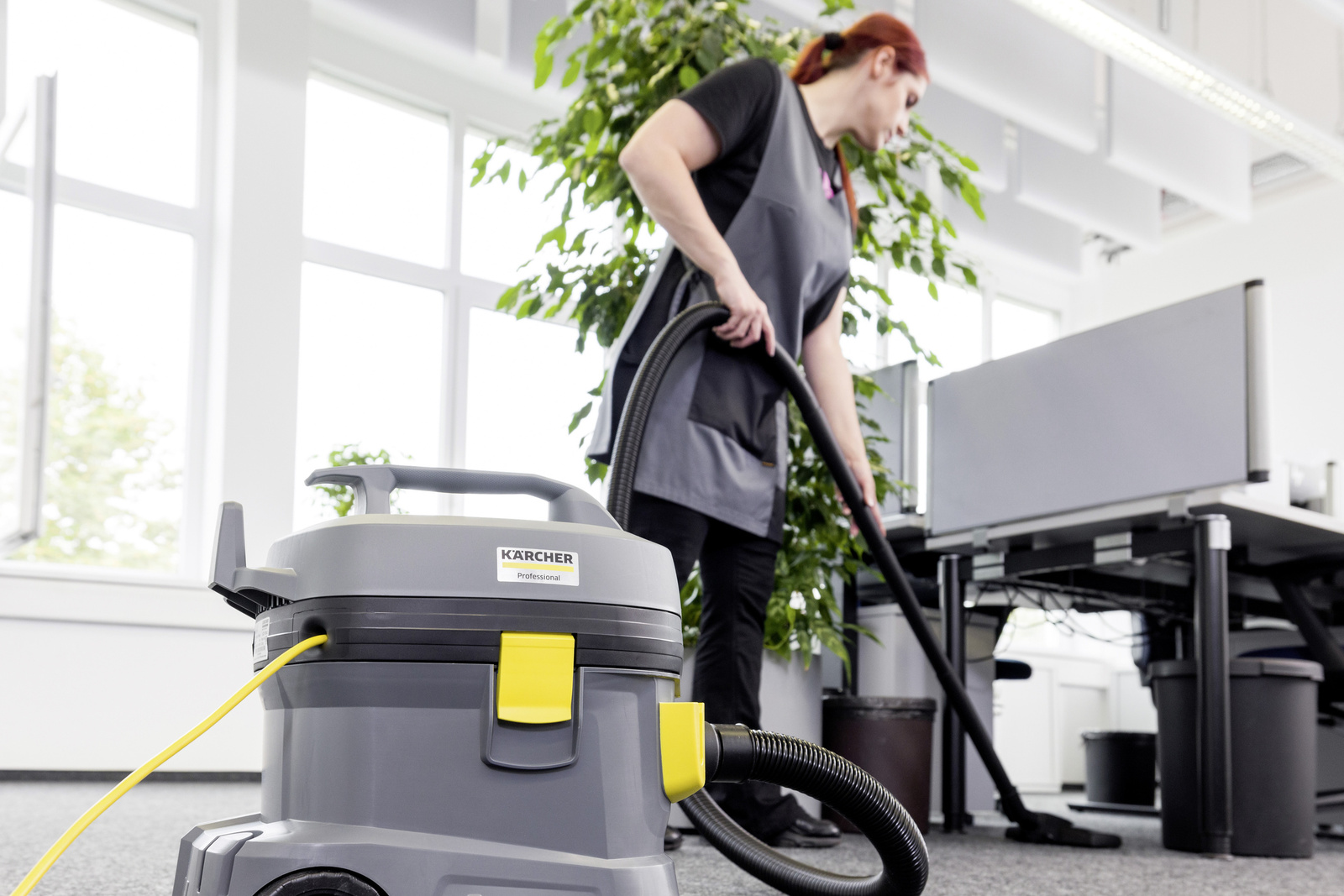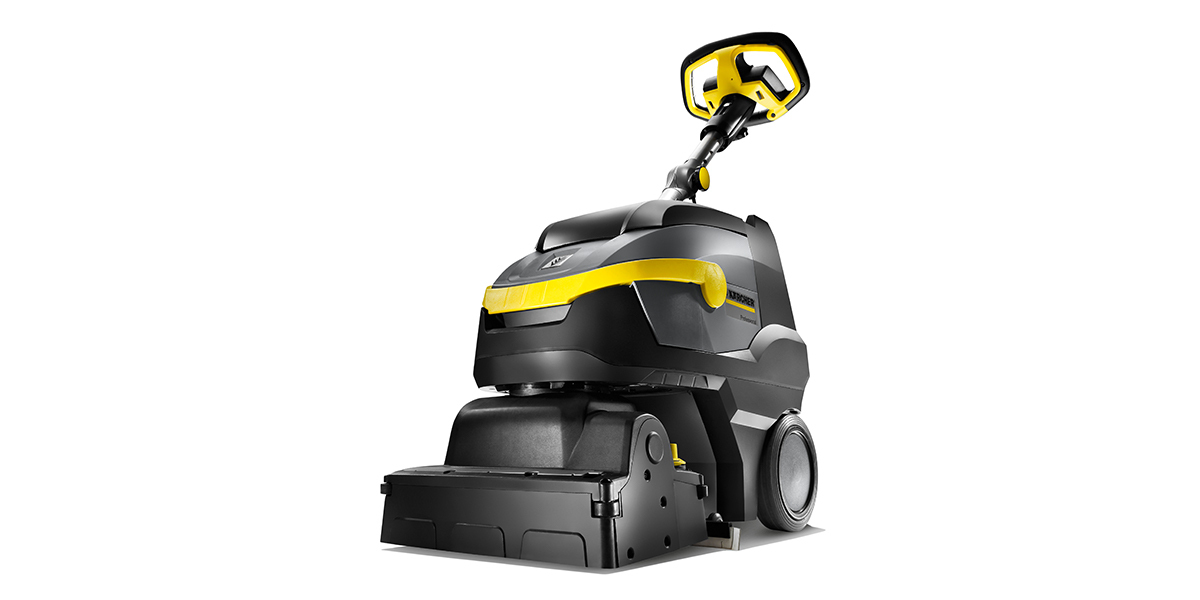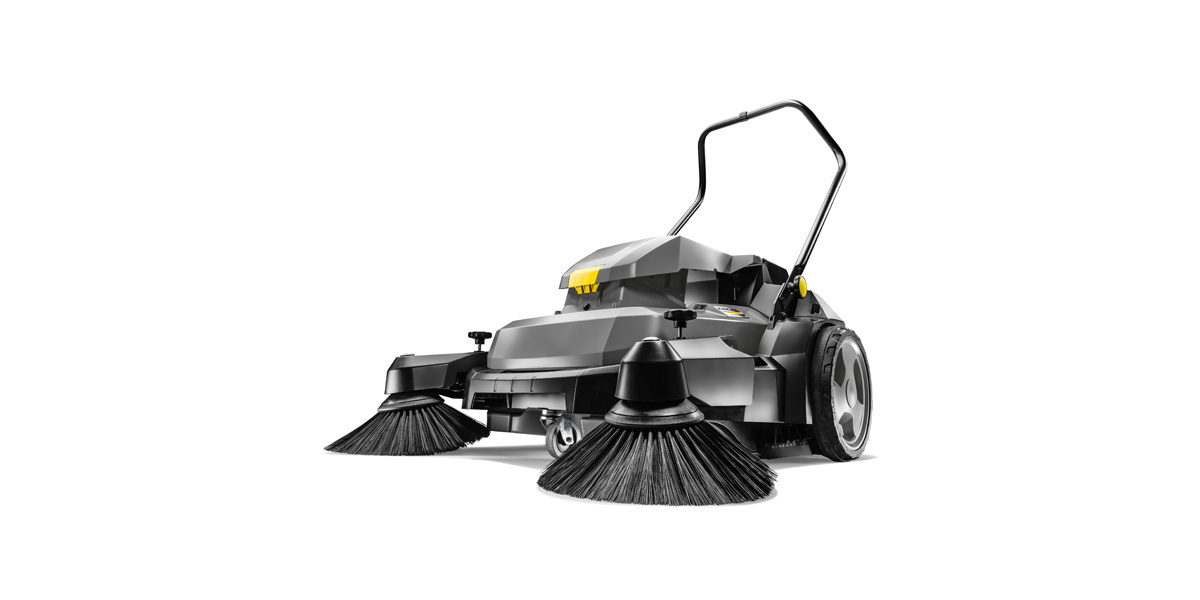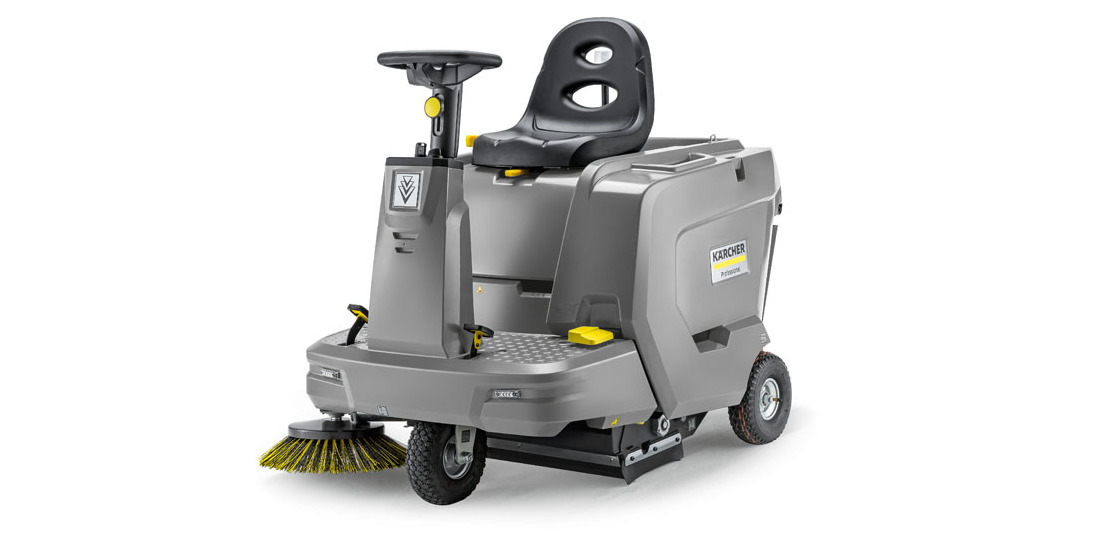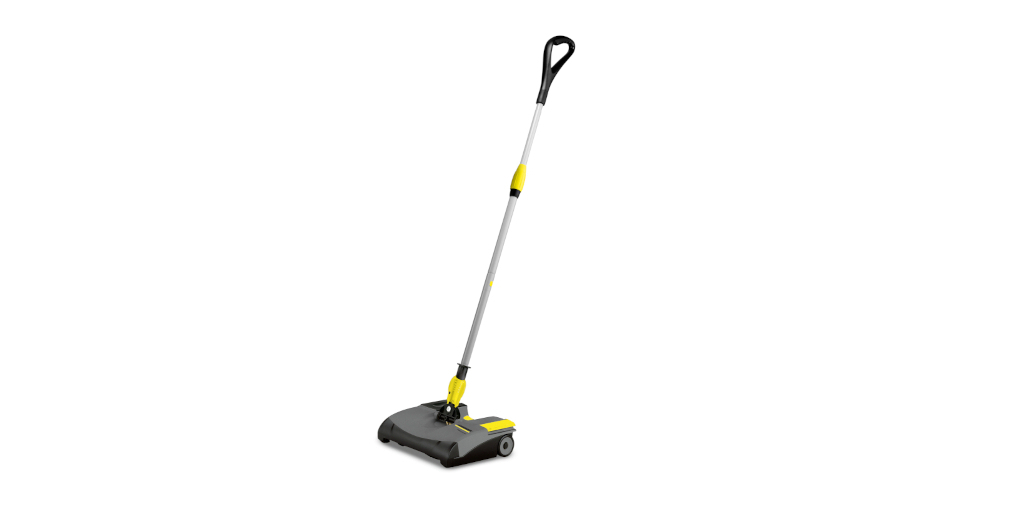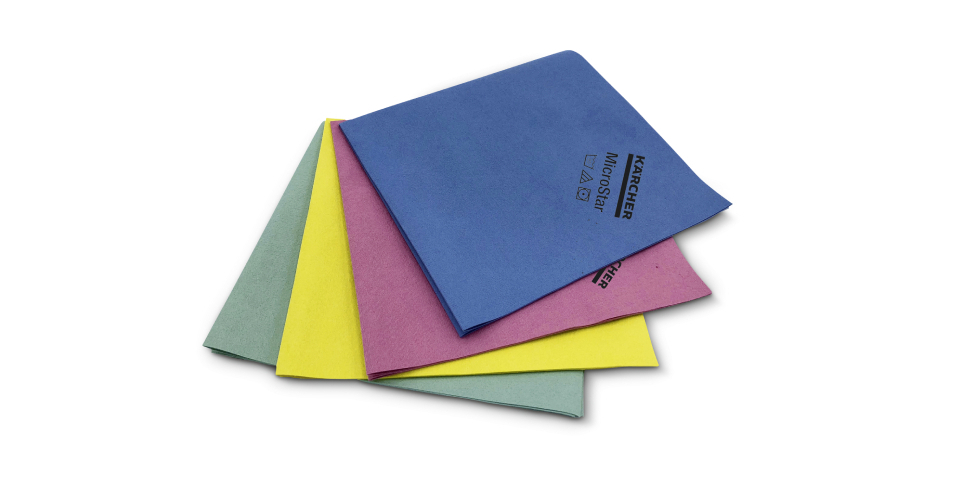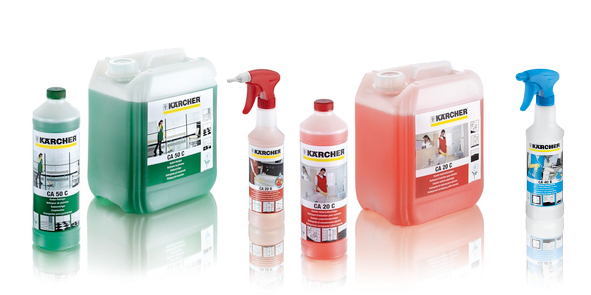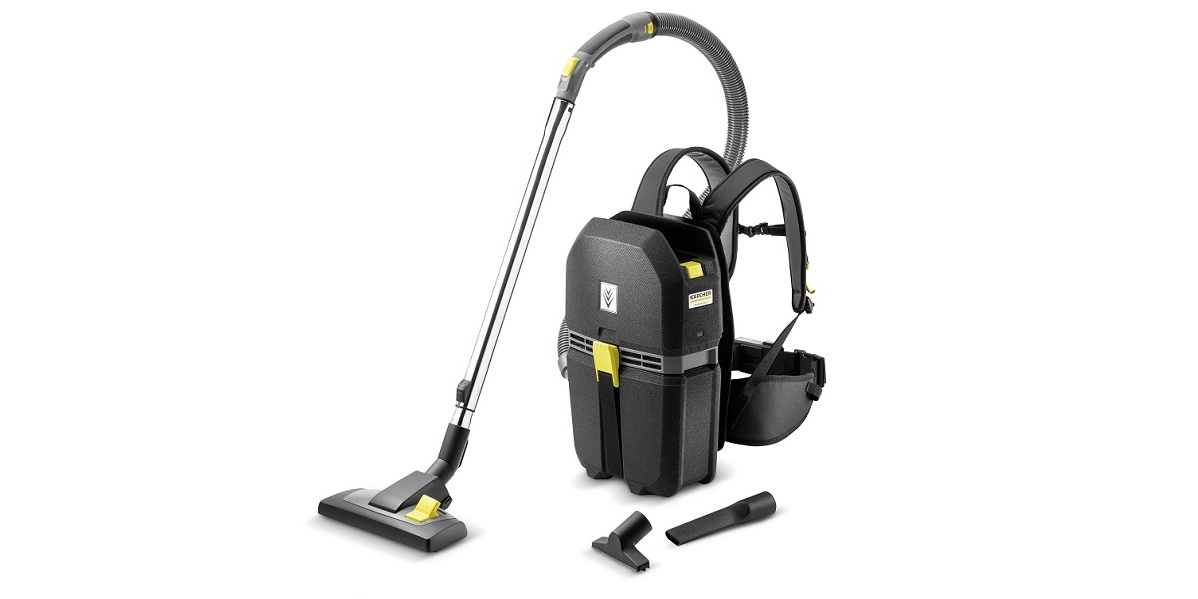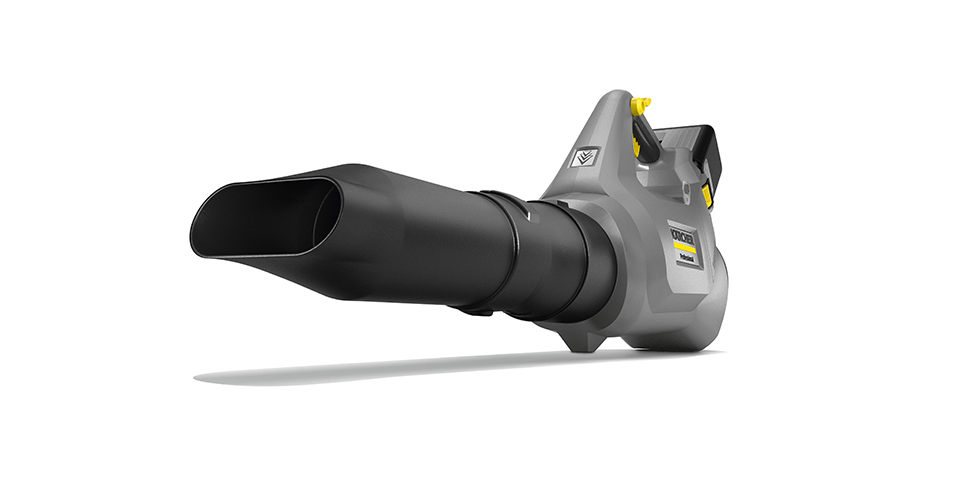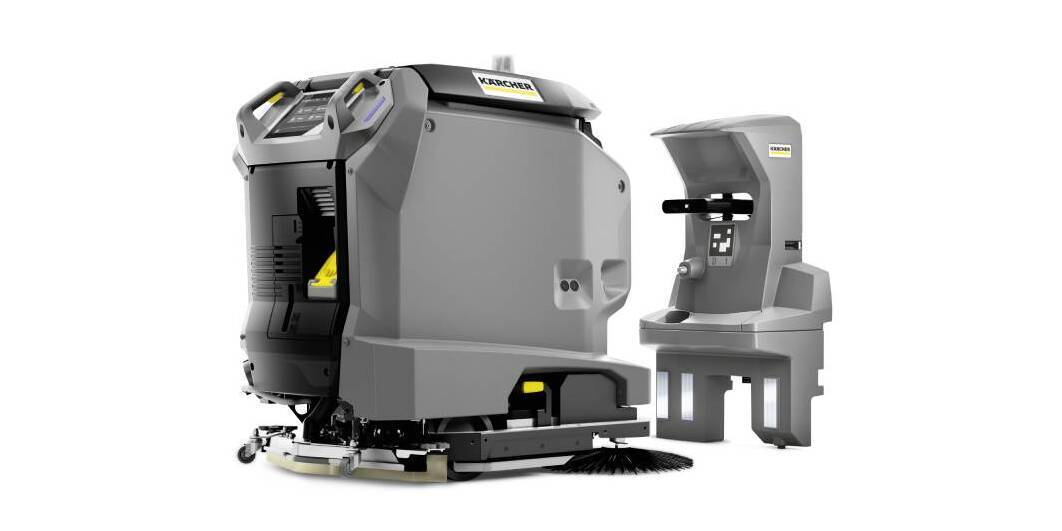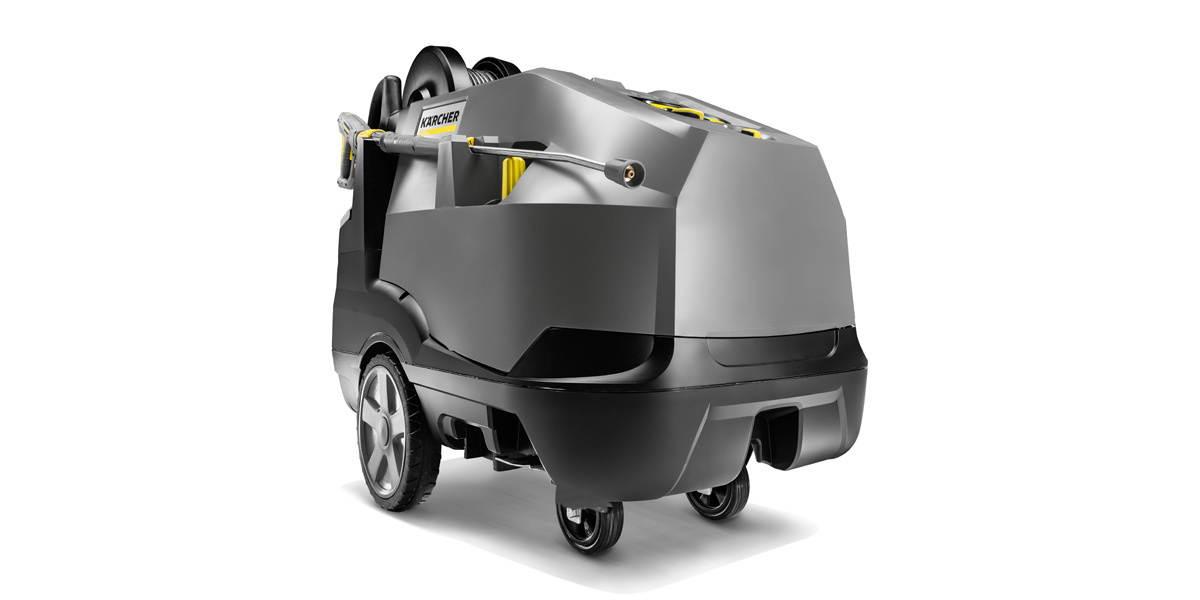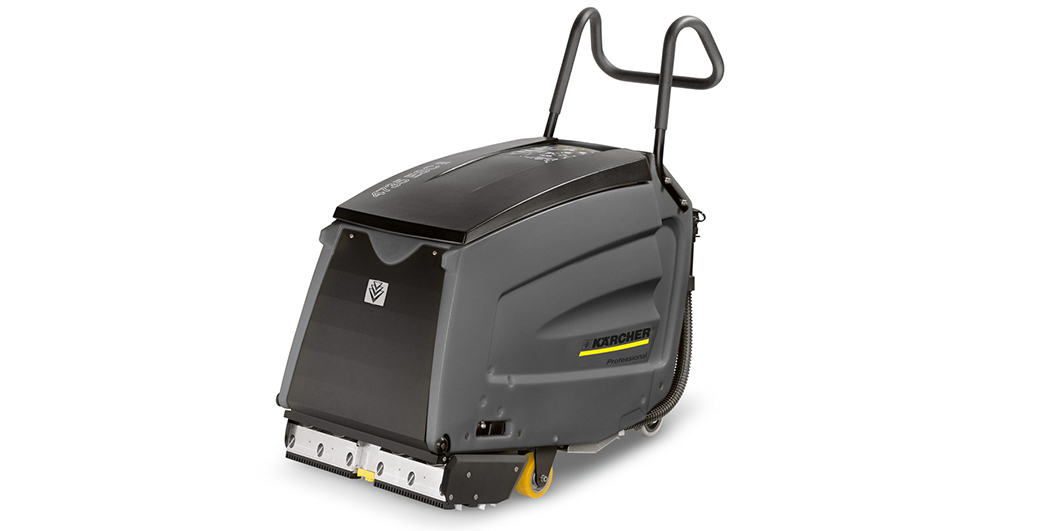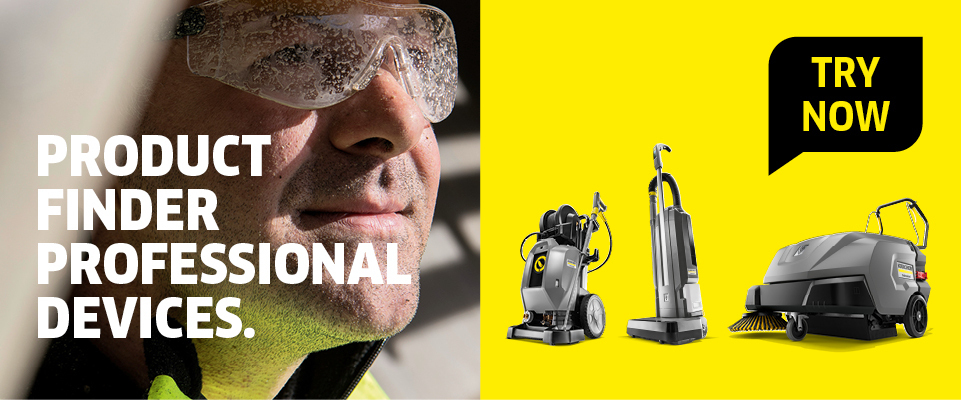Cleaning shopping centres
The range of goods and services on offer in shopping centres is as varied as the challenges of cleaning them are complex: large expanses with a lot of public footfall, plus special infrastructure such as escalators, toilet facilities or food courts – all areas need to be monitored to ensure customers feel comfortable when shopping. To complete all these different tasks efficiently, it is essential to have a carefully considered cleaning concept and the right cleaning technology. Robotics and sensor technology paired with digital systems present an economical solution to this workload. Cleaning also serves to preserve the value of the property.
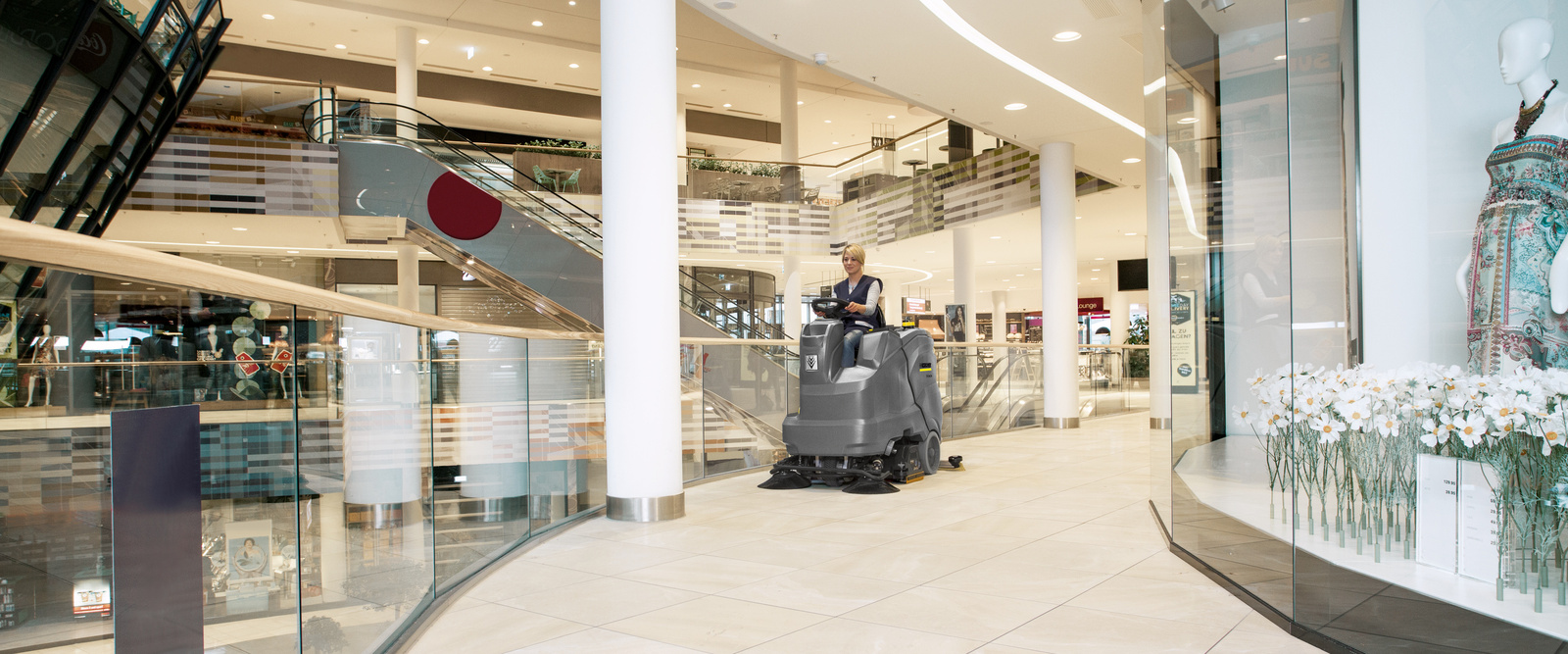
Systematic cleaning in the shopping centre
A good concept such as PDIR (Preventative, Daily, Interim, Restorative) is fundamental to achieving high-quality cleaning results, reducing workload and lengthening the service life of surfaces or floors. A systematic approach is all the more important when it comes to complex environments such as shopping centres.
"P" for "preventative": prevention is better than a cure
To prevent dirt and dust from entering the building in the first place, preventive cleaning measures are crucial. This includes regularly clearing the outside area and parking facilities of litter, dust and dirt. In the entrance area, what are known as "clean-off zones" with suitable doormats further reduce the amount of dirt entering the shopping centre. This reduces the cleaning workload inside, saving time and money.
"D" for "daily": clean daily, reduce workload
A shopping centre sees a high rate of footfall every day. Contaminants should be removed as soon as possible using the appropriate methods, as this is usually quicker in the long run – lifting a stain straight away is easier than removing dried-on stains. Daily cleaning also helps to prevent the spread of dirt and germs, which is a big plus in terms of safety and hygiene.
"I" for "interim": intermediate cleaning for value preservation
If daily cleaning is no longer sufficient, more intensive (yet economical) methods should be implemented as necessary to keep surfaces and floors clean. A regular intermediate clean extends the intervals between labour-intensive deep cleans, which reduces the time taken, lowers the costs and protects the environment.
"R" for "restorative": deep cleaning for value preservation
Even with the best care and regular intermediate cleaning, there eventually comes a time when a deep clean is needed. Restorative cleaning procedures make floors and surfaces look like new again. They extend the service life of the materials, thus ensuring value preservation and reducing repair and replacement costs in the long term. Suitable cleaning systems help to maximise efficiency and save resources.
Cleaning the outside areas of the shopping centre
The outside area has the task of attracting customers to the centre and should present an attractive image. Depending on the weather, a choice of equipment can be used for indoor and outdoor car parks, access roads, ramps and pavements. Stairwells, escalators and lifts are also important parts of the infrastructure and should be cleaned regularly.

There's no such thing as bad weather, when you have the right technology
A clean outside area is crucial to ensure that visitors feel at ease in a shopping centre from the moment they arrive and to stop the dirt from getting inside in the first place. Depending on the weather conditions, there are different technical aids to speed up the job of cleaning outside spaces. When the weather is warm and dry, car parks, access roads, access ramps and even footpaths can be cleaned using vacuum sweepers. Push sweepers or ride-on models are ideal for picking up loose dirt from paths, entranceways, multi-storey car parks or open-air car parks.
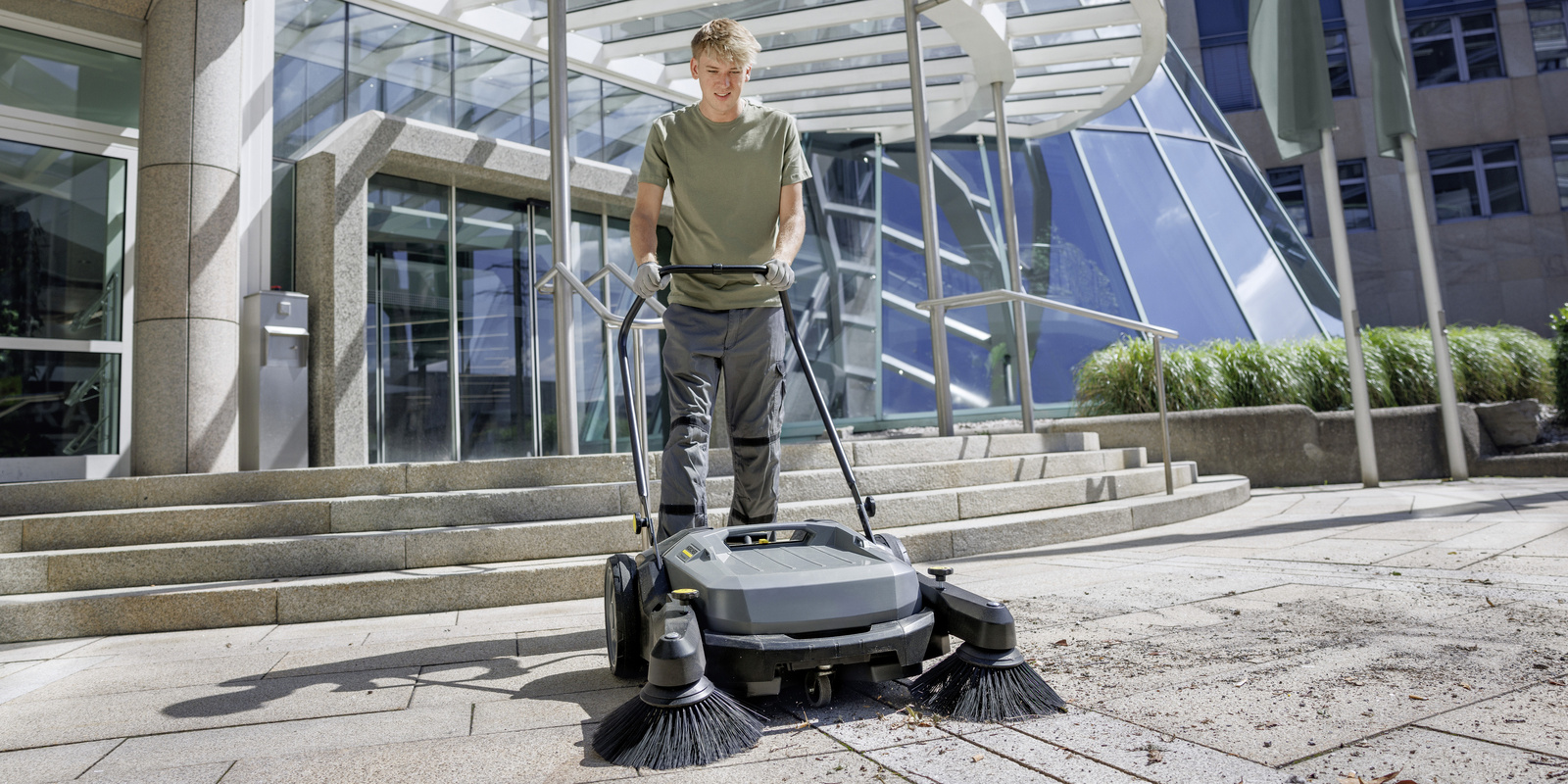
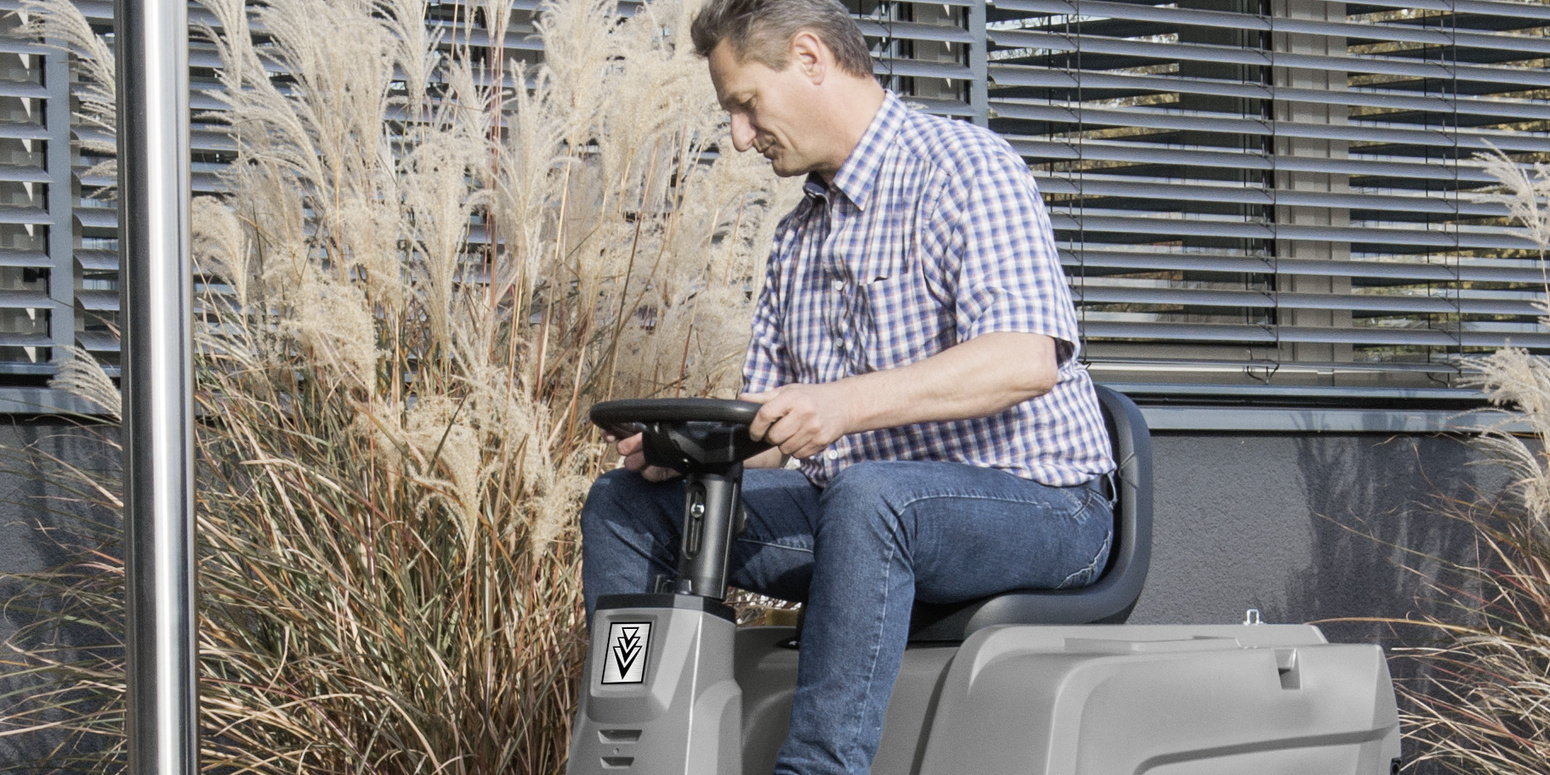
Tip 1 – Effective dust control:
The major advantage of vacuum sweepers is that they vacuum up the whipped up dust particles straight away, rather than covering parked cars with dust.
Tip 2 – Hygiene and safety in the car park:
Pay machines in car parks are touched by countless hands every day and should therefore be cleaned regularly and disinfected as necessary to prevent the transmission of germs.
Tip 3 – Efficient cleaning solutions:
Sweepers with an easy-to-open coarse dirt flap are the most user-friendly option for removing litter found around shopping trolley parks. The shopping trolleys themselves can be cleaned with hot water high-pressure cleaners.
When the days are cooler and wetter, scrubber dryers are the right choice for tackling salt and ingrained dirt. If litter, coarse debris and leaves need to be removed from the premises, leaf blowers can be helpful. Battery-powered models offer the advantage of being quieter and therefore less disruptive for visitors. What's more, they are lighter and more user-friendly, since the cleaning staff are not exposed to any exhaust fumes. No CO2 is emitted either, which is good for the environment.
In the event of snowfall, the appropriate clearing and gritting solution must be selected depending on the amount of snow and the site. A snow shovel is normally sufficient for manual work. A small snow thrower can easily cope with larger amounts of snow.
Tip – Focus on ergonomics:
Handheld machines with carrying straps facilitate fatigue-free work and machines with spring-loaded blowers significantly reduce the vibrations for the user.
Cleaning outdoor spaces, paths and car parks
Whether dining in a restaurant, shopping in a supermarket, furniture store or shopping centre, or visiting a doctor's surgery or a museum – often the first thing guests do upon arrival is to park their car and make a short walk to the building. There are a number of cleaning methods that can be used to make a positive impression right from the start, to prevent the risk of accidents and to stop dirt being brought in from outside.
Cleaning outside spaces
Cleaning outside spaces is an important pillar of building cleaning services. Roads, paths and car parks need to be kept tidy, glass surfaces need to be cleaned, and smaller details, from cigarette bins to handrails on external stairs, must not be overlooked. Plus, the entrance area and dirt trap zone must be cleaned regularly. Well worth the effort: a positive first impression is created, the property value is preserved and the amount of cleaning work required indoors is reduced. A good cleaning concept and the right equipment help you to achieve your goal efficiently.
Winter services
Climate change and the transport revolution present winter service teams with immense challenges, including environmental impacts such as reduced snowfall, the sudden onset of winter weather or black ice. At the same time, cycle path networks are being massively expanded, as more and more road users switch to two wheels for the sake of the environment or to counter rising fuel costs. What methods are available for local authorities, municipal maintenance depots, external service providers and building service contractors to keep working ecologically, economically and ergonomically? Which implement carriers and implements are used for which jobs?
Green space maintenance
Mowing lawns, landscaping green spaces, keeping hedges and trees in check: the list of jobs for green space maintenance teams is a long one. Powerful cordless machines are now available on the market for many tasks, from brush cutters to pole-mounted pruners and hedge trimmers. There are also various types of mower designed for implement carriers, sustainable options for weed removal and safety vacuum cleaners to aid in the fight against the oak processionary moths.
Cleaning car parks
Whether hotel multi-storey car parks, underground car parks at airports and shopping centres or public car parks, guests, passengers and customers are given a first impression the moment they park their vehicle. Cleanliness plays an important role here, because a well-maintained space is not only visually appealing, but also gives people a sense of reassurance. A structured approach to cleaning is therefore very important, with efficient cleaning technology taking the strain off staff and ensuring good results.
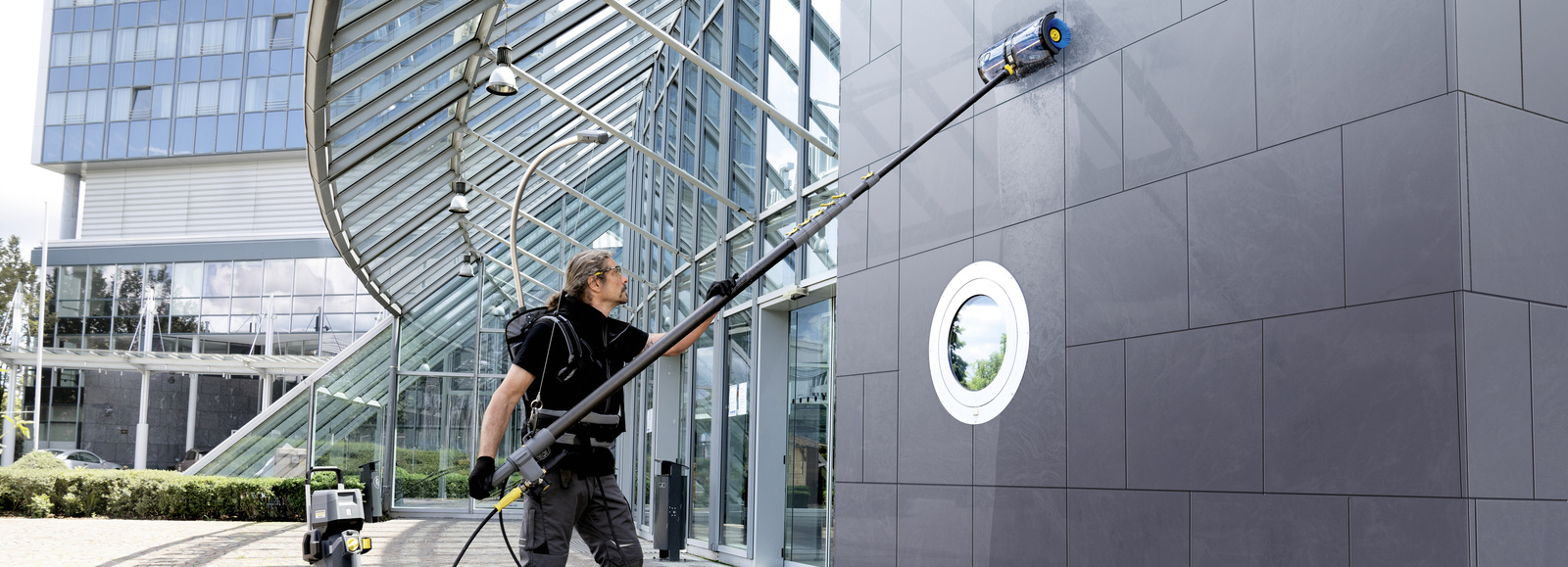
Fresh-faced: facade cleaning
Plaster, natural stone, glass or wood: a variety of materials on the facade gives a shopping centre its own unique face. To keep it looking as attractive as possible and to maintain the value of the property, regular, professional facade cleaning is necessary. Depending on the building material and the type of dirt, different techniques may be appropriate, such as low, medium or high-pressure cleaning with suitable accessories, including roller brushes. To prevent damage to the material and to ensure the dirt is removed efficiently, these techniques must be applied professionally.
Facade cleaning
With our new system solution comprising brushes, telescopic lances, attachments and adapters, a variety of cleaning methods can be used flexibly for different cleaning tasks. Whether with low, medium or high pressure, or even vacuuming, it's never been easier to clean facades, glass surfaces, solar panels and floors flexibly and thoroughly, even in hard-to-reach areas.

Moving on up with cleaning technology (1): stairwells
Depending on the architecture of the shopping centre, there are often several strategically located stairwells, such as in multi-storey car parks. Keeping these stairwells clean is challenging, due to the tight spaces. Loose dirt can be removed easily with a battery-powered backpack vacuum. The advantages: there are no cables to trip over and there is no need to hunt for sockets. Ingrained dirt can be removed using a mop. In addition to this, it is important to regularly clean and disinfect handrails to prevent germ transmission.
Tip – Cleanliness in car parks:
Chewing gum, road dirt and even urine: stairs in multi-storey car parks are often very dirty. Depending on the environment and condition, dirt can be removed efficiently with high pressure cleaners or steam cleaners.
Cleaning stairwells
Stairs can be real design elements, made from shot-peened steel or precious wood. They can be central escape routes or merely neglected pathways between the floors. In each case, cleaning jobs on a stairwell become a challenge because the spatial conditions make for hard work. Why is cleanliness still important? What must be kept in mind for various floor coverings? What are the most common operator errors? Here is an overview.

Moving on up with cleaning technology (2): escalators and moving walkways
Moving walkways and escalators in shopping centres convey a large number of customers every day, giving shoppers a more relaxed experience. For stubborn stains such as drink spills or food residues, wet cleaning is unavoidable even here. Chewing gum, small stones and other coarse impurities that have become lodged in the profile must first be removed manually with a scraper and then picked up with a dry vacuum cleaner. To get the escalator dazzling again, an escalator cleaning machine is an efficient choice. The guide ridges of the machine line up with the escalator and seal the surface of the escalator to the suction channel, creating the necessary vacuum to establish suction. The combs are available in compatible designs for all common escalator brands. Side walls and handrails should also be cleaned regularly.
Tip – Effective cleaning of handrails:
There is a practical way of cleaning the handrails: microfibre cloths are pretreated by soaking in disinfectant then these are simply held against the handrail as it moves.
Cleaning escalators and moving walkways
Escalators and moving walkways are a common sight in shopping centres, airports, railway stations and other public buildings. The task of cleaning these is often put on the back burner, but over time stubborn dirt builds up, some of which leaves sticky residues. To keep escalators and moving walkways looking as good as new and to give visitors a pleasant impression, they need to be cleaned regularly. Escalator cleaners are a practical solution that minimise the need for manual work.

Moving on up with cleaning technology (3): lifts
Just like stairs and escalators, lifts are exposed to high traffic volumes and face spatial constraints. They should therefore be inspected several times a day. Loose dirt can be picked up from the floor using a backpack vacuum or an electric broom. Ingrained dirt is best tackled with a mop. A practical solution for glazed or mirrored elevators is a handheld battery-powered window and surface vacuum cleaner. The advantage: the machine vacuums the water straight back up. This prevents not only the risk of slipping but also contamination from splash water.
Tip – Cleaning glass and metal surfaces:
Greasy soiling on glass and metal surfaces can be completely removed using steam cleaners and a microfibre cloth.
Shopping centre: efficient cleaning over large areas
In the shopping centre itself, there are a number of cleaning tasks to be completed, with the floors taking up a particularly large portion of time. Alongside vacuum sweepers and scrubber dryers, cleaning robots make a helpful and efficient addition. With digitalisation and sensor technology, cleaning can now be tailored to requirements, which saves unnecessary trips.

A colourful array of tasks: the daily cleaning routine
During the day, daytime cleaners – or "hygiene stewards" as they are known – are on the move, cleaning up visible dirt and debris at critical points. The cleaning tasks are varied: seating areas must be cleaned, finger marks must be removed from glass surfaces and litter bins must be emptied. Dust control mats need to be vacuumed regularly over the course of the day and dirt and spillages should be cleaned up as and when they occur, using a mop, electric broom or a compact scrubber dryer. These cleaning measures must be repeated once again at closing time to make sure everything is ready for the next day.
Tip – Specialist cleaning:
Full-surface glass cleaning is a specialist cleaning task that is usually carried out by external service providers.



Viewing daytime cleaning as an opportunity
Building service contractors are struggling with a massive shortage of skilled labour, compounded by time and cost pressures. Switching from after-hours cleaning to daytime cleaning may present a highly beneficial solution. The more attractive working hours of daytime cleaning increase staff motivation and make it easier to recruit new employees. When cleaning staff are present during the day, customers benefit because the quality of cleaning is improved. However, employees should receive professional training to ensure this switch goes smoothly. Digital technologies and robotics provide further support.
Full-surface floor cleaning: vacuum sweepers, scrubber dryers, robotics
Full-surface floor cleaning is generally scheduled for off-peak times so as not to disturb shoppers. Vacuum sweepers remove dust and sand quickly and efficiently. Dry cleaning methods are normally fully sufficient, provided there is no ingrained dirt. This saves time and therefore increases the cleaning team's productivity. Vacuum sweepers are also suitable for granite floors and rubber floor coverings, making them a versatile option for both matte and polished/high-gloss surfaces. When wet cleaning methods are called for, however, scrubber dryers are the perfect choice. For maintenance cleaning of artificial stone floors made from soft stone, diamond pads can be used to retain the floor's shine.
Cleaning robots can be used to assist employees and save valuable time. This means that even large areas can be cleaned at night. Beforehand, however, it is advisable to divide the areas to be cleaned into sections based on the frequency of use and the degree of soiling. For example, the entrance area could be cleaned more often, whereas the third floor with little footfall could be cleaned less often.
Tip – Uniform appearance:
The cleaning team must first check whether this effect is actually wanted by the ordering party. A uniform image can be achieved through careful working methods.
Cleaning floor coverings
Whether carpeting in a hotel corridor, cement screed in a production hall or wooden flooring in a school building, there are countless floor coverings that are suitable for different loads and ensure safety through properties such as anti-slip design or studs. Cleaning floor coverings is important in some areas to ensure hygiene, while in other areas the focus is on appearance. In any case, well-maintained floor coverings have a longer service life and therefore need to be replaced less frequently. Through regular maintenance cleaning, even the need for labour-intensive deep cleans can be delayed.
Robotics
People cannot be replaced in building cleaning services, as much of the work can only be done manually. However, due to the growing shortage of skilled labour in many countries, it is becoming increasingly important to reduce time-consuming activities and work efficiently. The use of robotics in building cleaning services is nothing new, but some models now work so autonomously that they represent a clear reduction in the workload for certain applications. Easy operation and high safety standards for working among the general public also mean they can be implemented for a wide range of application scenarios, from supermarkets and hospitals to airports.
Special cleaning tasks from the toilets to the offices
In areas such as food courts or toilet facilities, cleanliness is key to ensuring that customers and guests feel comfortable. When it comes to cleaning the retail stores themselves, the challenges vary depending on the type of products on sale.

Dirt-free dining: food courts
A long day of shopping makes you hungry. Cleanliness in food courts is essential to give visitors the best break possible. The tables should therefore be checked regularly. As soon as a table is vacated, all surfaces and touch points on the table and chairs must be wiped down with a damp cloth. Microfibre cloths effectively remove soiling thanks to their lipophilic (grease-dissolving) properties. The dust mop and electric broom are then used to remove crumbs from the chairs and floor. A spray mop is a quick and practical tool for cleaning up spilt drinks, etc. Thorough floor cleaning takes place after closing time so as not to disturb guests.
Cleanliness creates peace of mind: especially when nature calls
In toilet facilities and washrooms, cleanliness is paramount, because nothing is more off-putting than a neglected toilet. As such, they should be cleaned thoroughly at least once a day either before or after opening hours and as required. Besides the toilet, the baby changing table is a particularly sensitive area that needs to be cleaned daily and disinfected if necessary. Mirrors, shelves and sinks should also be thoroughly cleaned at least once a day. The colour-coding method prevents the transfer of germs, as the different colours of the cleaning textiles represent the different areas of use: the signal colour red is reserved for urinals, toilets or splash areas. Yellow cleaning textiles are used for all other areas of the facilities. To prevent streaks from forming when cleaning the mirrors, we recommend using suitable microfibre cloths together with a ready-to-use glass cleaner. The different colours ensure the safety of the cleaning staff. Cleaning trolleys and cleaning equipment should be located as close as possible to the place of use, so that staff can access them quickly – although preferably somewhere inaccessible to guests.

Tip 1 – Cleaning toilets:
The cleaning staff should also check the toilet brush for cleanliness when cleaning the toilet.
Tip 2 – Toilet checks:
During the day, it is important to regularly check that toilet facilities are clean and to restock supplies, such as soap, hand towels or toilet paper as required, and to empty the rubbish bins.
Cleaning sales rooms: clean and hygienic
Healthy eating for a healthy life – more and more people are seeing the importance of what's on their plates. Whether using fresh products from a farm shop to make dinner or grabbing a quick lunchtime snack on the go from a kiosk, one thing is vital – there must be scrupulous hygiene standards. Cleanliness and hygiene in sales rooms are fundamental to this. Thorough cleaning is therefore mandatory.
Cleaning changing rooms and toilet facilities
There are many reasons why careful cleaning is required in toilet facilities and washrooms: depending on the setting, toilets, showers and changing rooms in office buildings, production facilities, hotels, restaurants, sports halls or shopping centres are used by many people. This inevitably leads to people's skin coming into contact with various different surfaces that have been touched by practically all users of the facilities – including door handles, taps or toilet flush buttons. Consequently, microorganisms can pass from one person to the next. This must be prevented by means of defined cleaning sequences.

A window into the shops: cleaning mostly done by shop staff
The service provider that cleans the shopping centre's infrastructure is not usually responsible for the retail stores themselves, as they hire their own service providers or the shop staff to do the cleaning. The requirements for cleaning also vary depending on the type of shop: in a fashion shop, for example, space is tight and there is a lot of dust, which is why dry vacuum cleaners are a good solution. Cleanliness is particularly important in the fitting rooms, where loose dirt can be removed with a battery-powered backpack vacuum. In electrical shops or mobile phone stores, on the other hand, it's the shine that counts, the focus therefore is on regularly cleaning surfaces to rid them of fingerprints. Supermarkets, on the other hand, have completely different requirements in terms of cleanliness, as even higher standards apply when dealing with food.
Cleaning supermarkets
From the oven of the in-store bakery to the glass surfaces at the deli counter and the freezer cabinets, cleaning a supermarket is a varied and demanding task. Hygiene is also a key issue on surfaces that come into direct contact with skin and/or food. A consistent cleaning concept is needed to give customers peace of mind and enjoyment when they shop. Choosing the right technology is just as important as keeping an eye on the relevant details.
Back-of-house infrastructure: offices and other administration rooms
Administrative rooms and offices can often be found in shopping centres. To make employees feel comfortable and create a good working atmosphere, floor surfaces should be regularly cleaned of loose dirt using a dry vacuum cleaner or dust mop. Where necessary, ingrained dirt should be wet cleaned with a microfibre mop or a compact scrubber dryer, depending on the size of the rooms. Surfaces such as desks, file trays, etc. can be cleaned easily and efficiently using the pretreated cloth or spray method.

Cleaning offices
Office cleaning takes place in a challenging environment where multiple different priorities come into conflict: time and cost factors, cleaning results, hygiene and sustainability are all interconnected and must be taken into account. As such, it is important to choose the right cleaning methods for the challenge in question. Particularly with a view to ensuring hygiene and sustainability, static cleaning will increasingly be replaced by dynamic cleaning in the future.
Suitable products for your area of application
Find a wide range of technology at lightning speed – with the Kärcher Professional product finder
In no time at all, we'll show you the exact Kärcher Professional machine that best suits your specific cleaning task.


